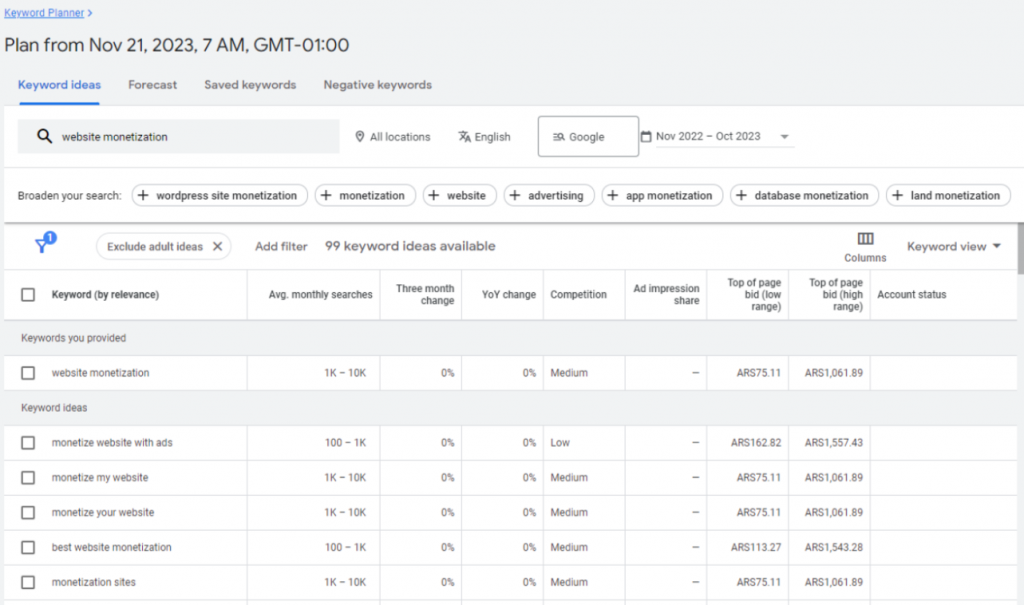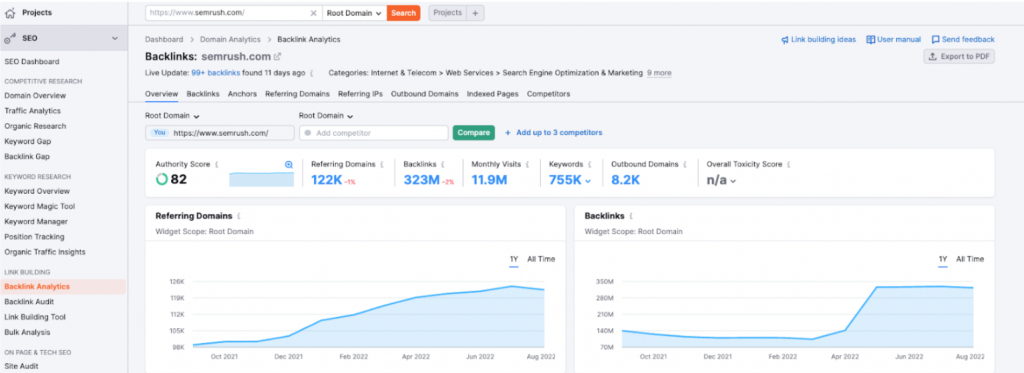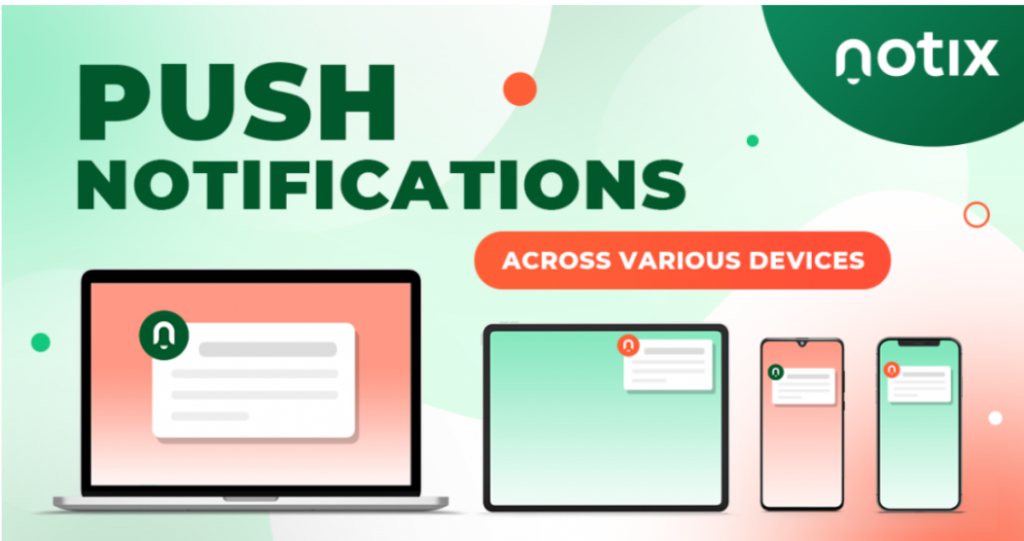Gone are the days when website monetization seemed like rocket science and was reserved for only a few. Today, anyone can build an excellent website, obtain visibility, and turn traffic into revenue.
The possibilities are endless.
But you’re wondering — how do you navigate the sea of strategies to find what truly works?
Below, we’ve compiled a list of practical steps to monetize your website.
This is not your typical guide but a checklist providing actionable insights and a definite roadmap for pulling in consistent traffic and transforming your website into a constant revenue stream.
If you’re ready, let’s get into it!
The Definitive Website Monetization Checklist
You can attract and monetize organic traffic through a myriad of strategies, but only a few are consistently effective. Here are ethically sound “white hat” approaches that will stand the test of both time and effectiveness:
Keywords Homework
Keywords are the foundation for achieving an excellent online presence. These are words, phrases, or questions that are entered into search engines when searching. When websites use them strategically, they can pop up among the results that appear, and this is what is known as search engine optimization (SEO).
As you might have guessed, some keywords are more competitive than others, and ranking them will be quite challenging. However, choosing keywords with no competition may mean low search volumes and traffic.
Therefore, the secret lies in balancing them out. You can leverage low to medium-competition keywords that may be easier to rank for, but do not completely neglect the more competitive options, too, especially as your website gains authority.
You can find relevant keywords for your website using the tips below. Don’t forget to check relevance to your website, search intent, competition level, and search volumes for the keywords you compile.
-
Leverage Google Free Tools
Google is the ultimate source of keywords, and they provide some free tools that can help you discover keywords to target. For example, the Google Keyword Planner gives you several related keywords when you enter a seed keyword.
Google Trends is another free online tool that tells you the trending keywords and the popularity of any keyword over time. Google Search Console is a website management tool that shows you keywords that bring traffic to your site.
-
Use Advanced SEO Tools
If you want more freedom with keywords, you can invest in an advanced keyword research and SEO tool, like Semrush, Ahrefs, Moz, SE Ranking, etc. Aside from revealing viable keyword opportunities, these tools will also show you detailed information like the keyword search volumes, traffic potential, difficulty level, etc.
-
Perform Competitor Research
Researching the keywords and generating traffic for competitors is a way of finding opportunities you can also take advantage of. You can learn who your competitors are by checking the top-ranking websites for the keywords you want to target and analyzing further with the abovementioned SEO tools.
-
Check social media and Online Forums
Going through discussions and trends on social media and other online forums will reveal topics people discuss or want to learn about. Creating posts around these will position you for more organic traffic.
Create Backlinks
Backlinks refer to links that are directed to your website from other websites. They are crucial for establishing your website as an authority in your niche and determining the relationship between web pages, especially when they’re coming from high-authority websites.
According to Google’s Andrey Lipattsev, quality content and backlinks are the top two most important factors for ranking your website, spammy backlinks may also harm your rankings.
How to Get Quality Backlinks?
You can also get valuable backlinks through guest posts or link exchanges. With link exchange (also called reciprocal linking), you will agree to link to another website in exchange for links on the other website pointing to yours.
Guest posting is when you offer to write for other people with links going back to your website. To guest post, research high-authority websites that are similar to yours. Reach out to them and propose the idea of producing content for them. Follow their guidelines and submit the content for publishing.
Analyzing Backlinks
It’s essential to check your backlinks from time to time to keep them in good shape. You can achieve this with Semrush Backlink Analysis, Moz Link Research, and Majestic Backlink Analyzer.
Backlink analysis will reveal pages on your website that get the most backlinks; improving those pages can boost traffic. If you find a website that consistently links to your website, reaching out for more partnerships like link exchange may be a good idea.
Mind Your Content
No matter what else you implement on your website, it can never be at the expense of valuable content because only through it can you engage and inform your audience.
Each content must be in-depth information and provide the solution to the search intent. Dividing your content into headings and subheadings, as well as writing in short sentences and paragraphs, helps keep readers engaged and includes statistics, facts, and references to back up your points.
It also helps to include visual content, such as images, screenshots, tables, and infographics, to help them understand the scope and encourage readers to share — like here:
Adding humor, stories, and real-life examples can be beneficial too.
Finally, you can win more readers to your corner and even improve search engine optimization by including frequently asked questions (FAQs). Other methods that could enhance SEO regarding your content include adding meta descriptions and alt texts to images.
Get the Most out of AI.
No doubt, artificial intelligence is a game-changer for content creation and optimization. AI tools are built to generate human-like content based on the input the user enters, known as prompts.
Examples of AI writers include OpenAI’s ChatGPT and alternative tools Google Cloud Natural Language API, IBM Watson Natural Language Understanding, Microsoft Azure Cognitive Services, and Hugging Face Transformers.
These AI tools allow you to create engaging and SEO-friendly posts and outlines faster. Follow the tips and best practices below to get the best of artificial intelligent content generators:
- Write detailed but concise prompts. The quality of the output depends on the prompts you input. Include all the information you want but avoid unnecessary details that may confuse the AI.
- Tools like ChatGPT are conversational. Hence, you can write like you’re having an everyday conversation.
- Specify anything that could improve the response, such as the style, tone, context, audience, limit, etc.
- Use the responses an AI tool gives you to refine the prompts for better results.
- Fact-check any data you get from AI tools, as they sometimes supply incorrect information.
- If there is any content you want the AI tool to model, you can supply it and write the prompt accordingly. You can also provide examples.
- If you have multiple queries, it may be better to separate them, especially if they aren’t related.
You can also leverage AI tools for keyword research (e.g., ChatGPT), optimizing meta tags (e.g., Rankmath Meta Tag Analyzer), headline analysis (e.g., UNmiss Headline Quality Calculator), and creating more relevant content (e.g., Clearscope).
Segment Your Audience
Your website’s organic traffic will increase if you can keep users coming back to your website; that is where push notifications come in. Push notifications are alerts sent to users, notifying them of an update that should interest them enough that they want to visit your website.
For push notifications to be effective in helping you drive repeat visits to your website, you need to segment your audience. Audience segmentation refers to adding each subscriber to a specific list so you can deliver content that aligns with their interest.
Delivering personalized content also reduces churn rates, boosting open and click-through rates. This will ultimately lead to a loyal, engaged following and much easier tracking.
To illustrate the power of push notifications and audience segmentation, let’s glance at a case study featuring Notix and Aglasem, an Indian education platform.
There was marked increase in the push subscriber base soon. Thanks to Notix settings that allow to separate subscribers depending on their education level, Aglasem users now receive only relevant updates.
So, how can you segment your audience?
Using push notification tools like Notix, you can segment your audience based on the factors below:
-
Website content
You can segment subscribers based on the types of content or topics you share on your website. Do you have informational and transactional posts, or are they news and reviews? That’s a good way to segment based on website content.
-
User behavior
You can do audience segmentation based on how users interact with your website. For instance, you can separate new and old subscribers into frequent and occasional visitors.
-
Location
Location is another excellent criterion for segmenting users. Perhaps you offer weather information services as in the case study mentioned above or similar location-dependent services; you can use location to select the information each person receives.
-
Device
Segmenting based on devices can be beneficial not only for personalization but also for analytics. You can use this to analyze how desktop and mobile users interact with your website. It’s also useful for personalization, especially in cases where some information will display better on certain devices.
Monetize With Push
When monetizing organic traffic, taking advantage of traditional monetization methods, such as display ads and affiliate marketing, is essential. While these have been around for a while, they’re still very much in use, even though they may present certain challenges.
However, no matter the route you choose, you’ll still need push notifications. Unlike traditional strategies, push notifications services like Notix allow you to monetize subscribers gently and unobtrusively.
With Notix, website owners can monetize these push notifications. They only have to switch to the monetization plan, and they will get the push service free of charge. Their subscribers will also start receiving messages with ads alongside push notifications.
Summary
Attracting and monetizing organic traffic is an ever-evolving aspect of the digital landscape. By combining a couple of strategies, you can gain more visibility from search engines and improve the website’s revenue.
When you implement keyword research, obtain high-quality backlinks, and create valuable content, you’ll have put all the basics in place. But with additional efforts like audience segmentation and push notifications, you’ll put your website ahead of the competition.
Each step is an essential chess piece movement, taking you closer to a digital checkmate, but adapting as you go on is quite crucial. As you apply the strategies above, you must monitor your progress, stay informed, and continue being innovative for more monetization opportunities.









